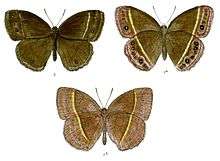Mycalesis lepcha
Mycalesis (annamitica) lepcha, the Lepcha bushbrown, is a satyrine butterfly found in Asia. It is not resolved whether it is best considered a distinct species, or included in Mycalesis annamitica. It was formerly included in Mycalesis malsara.[1]
| Lepcha bushbrown | |
|---|---|
 | |
| Scientific classification | |
| Kingdom: | |
| Phylum: | |
| Class: | |
| Order: | |
| Family: | |
| Genus: | |
| Species: | M. lepcha (but see text) |
| Binomial name | |
| Mycalesis lepcha (Moore, 1880) | |
| Synonyms | |
| |
Description
Wet-season form. Upperside very dark Vandyke brown; cilia whitish brown; the discal transverse white bar on the underside of the wings showing through very clearly, more distinctly on the forewing than on the hindwing; followed on both wings by two or three dark pale-ringed, generally non-pupilled ocelli, and subterminal and terminal pale slender lines. Underside: ground colour darker, the discal white bar and terminal slender line as on the upperside, but the former clear and well-defined inwardly, diffuse outwardly; forewing with four, hindwing with seven white-centred, fulvous-ringed, black ocelli; the rows of ocelli bordered on both sides by narrow crescentic pale purpurescent (purplish) marks forming somewhat irregular lines; subterminal line similar, lunular. Antennae, head, thorax and abdomen brown; club of the antennae ochraceous, marked with black on the inner side. Male sex-mark in form 2.
Dry-season form. Upperside similar but paler; the ocelli, especially on the hindwing, obscure or absent; the transverse white discal band on the wings seen by transmission from the underside narrow and very obscure. Underside: basal areas of wings up to the discal white band dark brown in the male, ochraceous brown in the female; the discal white band very narrow and ochraceous white; the terminal margins beyond purpurescent; ocelli minute; both forewings and hindwings irrorated with short, transverse, brown striae.
Race lepcha, Moore. The North-West Himalayan and Southern Indian race of M. malsara, closely resembling it in both the wet- and dry-season forms. It differs in having the transverse discal band crossing both wings very much narrower and not showing through at all on the upperside; the ocelli are very much smaller and more obsolescent. Underside in the dry-season form irrorated as in M. malsara with short, transverse, dark brown striae.[1]
Footnotes
- Bingham, C.T. (1905). The Fauna of British India, Including Ceylon and Burma Butterflies. 1 (1st ed.). London: Taylor and Francis, Ltd.
References
- Bingham, C.T. (1905). The Fauna of British India, Including Ceylon and Burma Butterflies. 1 (1st ed.). London: Taylor and Francis, Ltd.